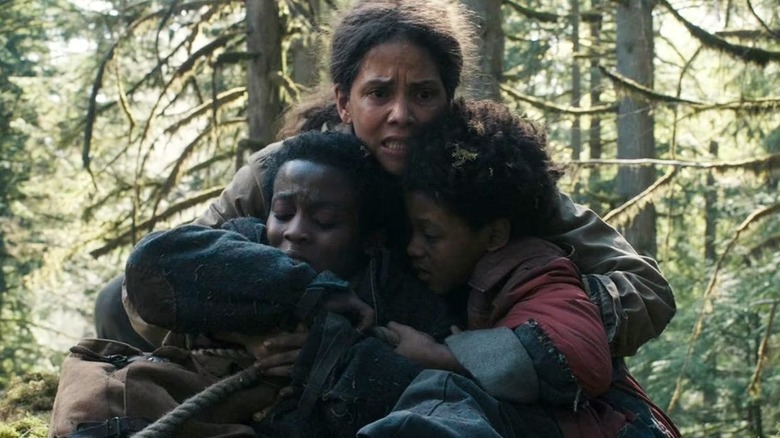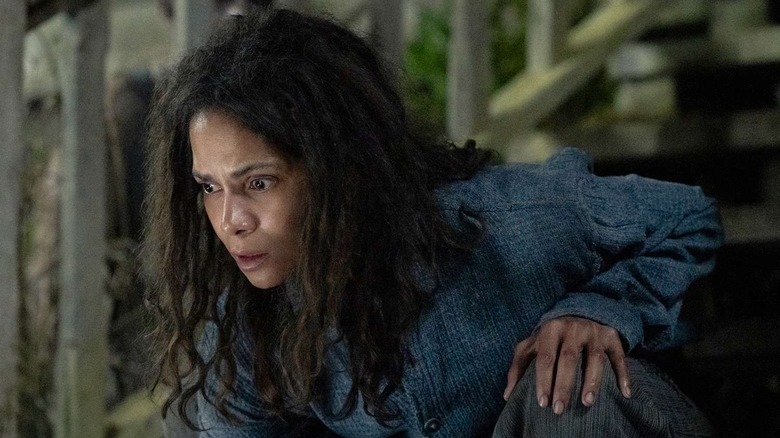Once upon a time, there was a filmmaker named Alexandre Aja. His career was fascinating in the way that it wasn’t entirely auteur-centric, as every director has his own unique stylistic habits and tendencies, but not everyone has a specific, strong signature. Aja has certainly always been a genre filmmaker, interested in subversion and twists, loving to play with genre conventions, and not afraid to use the audience’s sympathies against them. Whether it’s the brutal, New French Extremity slashers of “High Tension” and “The Hills Have Eyes,” or the happily exploitative “Piranha 3D,” the literary roots of “Horns” and “The 9th Life of Louis Drax,” or the suspense exercises of “Crawl” and “Oxygen,” Aja has always found ways to surprise and disturb (in every sense of the word) with his films.
All of this is to say that, in the case of Aja’s latest film, “Never Let Go,” its logline and marketing campaign make it part of the most recent theme he’s been exploring in his work, a suspense-forward genre exercise. Just like “a crocodile attack during a storm” and “a woman trapped inside an airtight cryogenic chamber,” comes a mother (Halle Berry) who lives in a forest inside an old wooden house with her twin sons, Nolan (Percy Daggs IV) and Sam (Anthony B. Jenkins). The world is believed to have ended; these three are the only remnants of humanity left. To make matters worse, they can’t leave the house without tying a rope around them, as it’s their only defense against a rampaging evil that has taken over the world, a power that can subjugate anyone with a single touch and is irreversible. Somehow, in the midst of all this, they must find a way to survive.
While this premise and the trailer make the film seem similar to the “A Quiet Place” franchise, “Never Let Go” has several surprises that make it completely different. Although its closest cousins are the work of M. Night Shyamalan as well as Trey Edward Shults’ “It Comes at Night,” Aja never presents the film as an intriguing “Gotcha!” or a gloomy “elevated” horror movie, but rather as a fractured fairy tale that constantly unravels and reveals new layers, all of which give the film an eerie and powerful grip.
Never Let Go starts building its fairy tale from the very first frame
Unlike Aja’s “High Tension,” “Never Let Go” isn’t a movie that tricks you into thinking you’re watching one story when it’s actually showing you another. Yes, it’s filled with twists, revelations and plenty of ambiguity, but it’s not a movie with any rug-pull twists. That’s one of its charms, as its tone and structure meshes seamlessly with the story’s themes. From the very first minute, the story, narrated in Nolan’s voice, begins to lay the foundation for the movie’s fairy tale, hinting that what we’re about to see isn’t going to be entirely natural. Even though Aja and writers Casey Coughlin and Ryan Grasby lay it on a little rough sometimes — there’s a scene where Momma reads “Hansel and Gretel” to Nolan and Sam — “Never Let Go” plays fair with its influences and its aesthetic aims.
Of course, fairy tales and horror stories are intertwined, so much so that many horror films this year have made heavy use of fairy tale elements. So, to put the film in plain terms: if “Longlegs” is urban legend and “The Front Room” combines cultural mythology with the metaphor of the “wicked stepmother,” “Never Let Go” examines the fragile state of their family through campfire tale logic mixed with religious fanaticism. In addition to requiring ropes to be placed around them when they go out, Momma also makes sure that Nolan and Sam “recharge” the love within their ancestral home by having them sleep in its small, cramped basement for a certain amount of time. If Nolan or Sam suspect that they have been touched by evil and/or have violated one of the rules, Momma tells them to chant a specific incantation when touching the wood of the house, which it seems someone infected by evil will not be able to do.
If this all sounds too weak as a belief system, congratulations: you’re right where Nolan begins the story, already wondering why he, his brother and his mother are stuck in a remote house in the woods, where food and resources are rapidly dwindling. In addition to the paranoia of “It Comes at Night” and the survivalist aspects of “A Quiet Place,” “Never Let Go” also examines the idea of faith from a perspective similar to Rose Glass’s “Saint Maud,” which seems like a bizarre and illogical system through the eyes of believers, who by their very nature can be unreliable narrators.
Halle Berry leads self-effacing cast
With this idea of blurring the lines of morality and even sanity within characters, all three of the film’s main characters give a performance that is remarkably without any pretensions. This is a film where things start off quite dangerously for the family unit and only get worse from there, not to mention the fickle nature of each of their allegiances and their morals. So the fact that they are all as charming as they are is a testament to their abilities as performers. Jenkins and Daggs in particular are real finds; both boys have an intensity and vulnerability that allows them to hold the screen with ease, and they may be my favorite child performances of the year so far.
For her role, Berry continues to make compelling and fascinating choices as an actress. They may not always work (see: her accent in 2000’s “X-Men”), but she can never be accused of not committing herself 100%. In “Never Let Go,” Berry doesn’t seem concerned at all about making Momma likable or completely understandable; like her character, she is unapologetically who she is, take her or leave her. Even though the boys are the people we follow for most of the film, Berry’s Momma is the film in miniature, refusing to be confined to one interpretation or another.
If you meet Aja halfway it becomes a haunting movie
As all of this shows, “Never Let Go” is a very subtle film, with the potential to disappoint viewers who are looking for a less complicated spooky hour. Also, like any story that is partly a guessing game, half the fun is trying to guess where things might go next, and it’s this aspect that Aja upends the most. As I said, he plays fair; perhaps too fair, as we’ve been given fairly solid answers to some of the film’s biggest questions in a shocking way early on. It’s just that these answers might not be the ones people are expecting, or the ones that completely satisfy them in the end.
Yet if you watch the film halfway through, “Never Let Go” manages to be fun and scary. Yes, there are scary scenes here, as Aja has honed his sense of jumpscare timing as well as his art of finding collaborators who can create some truly disturbing monstrous zombie creatures (another major collaborator of Aja’s, composer R.O.B. aka Robin Kudert, provides a richly layered combination of electronic and orchestral score). Of course, your opinion may differ, but “Never Let Go” seems to be a film that stays in people’s minds long after it’s over. It definitely has an immediate, visceral joy. But as the title suggests, it can stay in your mind for days (or longer), as it has in mine.
/Movie Rating: 8.5 out of 10
“Never Let Go” will be released in theaters worldwide on September 20, 2024.















